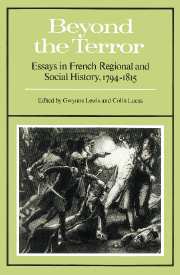Book contents
- Frontmatter
- Contents
- Contributors
- Preface
- 1 Cobb and the historians
- 2 The reconstruction of a church 1796–1801
- 3 Picking up the pieces: the politics and the personnel of social welfare from the Convention to the Consulate
- 4 Conscription and crime in rural France during the Directory and Consulate
- 5 Common rights and agrarian individualism in the southern Massif Central 1750–1880
- 6 Themes in southern violence after 9 thermidor
- 7 Political brigandage and popular disaffection in the south-east of France 1795–1804
- 8 Rhine and Loire: Napoleonic elites and social order
- Index
6 - Themes in southern violence after 9 thermidor
Published online by Cambridge University Press: 04 November 2009
- Frontmatter
- Contents
- Contributors
- Preface
- 1 Cobb and the historians
- 2 The reconstruction of a church 1796–1801
- 3 Picking up the pieces: the politics and the personnel of social welfare from the Convention to the Consulate
- 4 Conscription and crime in rural France during the Directory and Consulate
- 5 Common rights and agrarian individualism in the southern Massif Central 1750–1880
- 6 Themes in southern violence after 9 thermidor
- 7 Political brigandage and popular disaffection in the south-east of France 1795–1804
- 8 Rhine and Loire: Napoleonic elites and social order
- Index
Summary
Violence, intimidation, and murder quickly established themselves as an integral part of the revolutionary process in the south-east of France. However, from the Year III the violence attained a wholly new dimension in its intensity, its pervasiveness and its persistence. In the spring and summer of the Year III, jacobins in a broad area of the Midi fell victim to a massive wave of assassination and violence within the more general anti-jacobin revulsion of the Thermidorean Reaction that did not attain this level of murderousness elsewhere in France. In subsequent years, the level of this violence fluctuated. In the Year IV, it became more sporadic as a jacobin-minded Directory sought to instal jacobins in positions of local authority and gave them some fairly ineffectual support. Coinciding with the resurgence of ultra-conservatism and crypto-royalism around the elections of the Year V, the violence was renewed in what was sometimes called locally ‘the second reaction’. Strong government after 18 fructidor damped it down again in the Year VI. It resurfaced more sporadically from the later Year VI into the Consulate, exploding again in the White Terror of 1815. Although the pattern becomes less compelling after 18 fructidor, there was an essential continuity in this violence until then at least. It was one long bloody struggle between opposing groups of jacobins and counter-jacobins. In towns and villages, and even in a city like Marseille, essentially the same individuals were involved from one year to another. Very few new names appear in the documents; by and large, those missing are the victims of the previous round.
- Type
- Chapter
- Information
- Beyond the TerrorEssays in French Regional and Social History 1794-1815, pp. 152 - 194Publisher: Cambridge University PressPrint publication year: 1983
- 5
- Cited by

